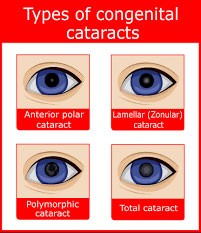Types of Cataracts
Cataracts come in a variety of types that can affect your eyesight in different ways. In general, cataracts are classified according to their location in the eye’s lens and according to their origin (i.e. how they initially developed).
come in a variety of types that can affect your eyesight in different ways. In general, cataracts are classified according to their location in the eye’s lens and according to their origin (i.e. how they initially developed).
There are three main types of cataracts based on location:
- Nuclear sclerotic cataracts – These cause the nucleus of your lens (the central portion) to harden and develop yellow cloudiness. This is the most common type of age-related cataract. Vision usually deteriorates gradually.
- Posterior subcapsular cataracts – These develop on the back of the lens, below the capsular bag that encases your lens. They can cause blurry near vision, light sensitivity, and halos and glare at night. This cataract is most common in patients with diabetes or patients who have taken steroids for many years.
- Cortical cataracts – These develop on the side of your lens (called the cortex) in the form of streaks or wedge-shaped opacities that scatter light.
There are four main types of cataracts based on origin:
- Age-related cataracts – Caused by the natural aging process.
- Secondary cataracts – Occur following certain types of eye surgery, such as surgical glaucoma treatment and retinal surgery. Can also develop after prolonged steroid use.
- Traumatic cataracts – Caused by injury to the eye (e.g. blunt trauma or chemical exposure).
- Congenital cataracts – In very rare cases, children can be born with cataracts.
If you are experiencing symptoms of cataracts, Dr. Brooks can restore your vision through state-of-the-art, no-stitch cataract surgery. Please contact Brooks Eye Associates today or call (972) 736-9347 to schedule a consultation with our experienced Dallas cataract surgeon. We serve patients in Plano, Frisco, and throughout Dallas, Texas.

Types of Cataracts
Cataracts come in a variety of types that can affect your eyesight in different ways. In general, cataracts are classified according to their location in the eye’s lens and according to their origin (i.e. how they initially developed).
There are three main types of cataracts based on location:
- Nuclear sclerotic cataracts – These cause the nucleus of your lens (the central portion) to harden and develop yellow cloudiness. This is the most common type of age-related cataract. Vision usually deteriorates gradually.
- Posterior subcapsular cataracts – These develop on the back of the lens, below the capsular bag that encases your lens. They can cause blurry near vision, light sensitivity, and halos and glare at night. This cataract is most common in patients with diabetes or patients who have taken steroids for many years.
- Cortical cataracts – These develop on the side of your lens (called the cortex) in the form of streaks or wedge-shaped opacities that scatter light.
There are four main types of cataracts based on origin:
- Age-related cataracts – Caused by the natural aging process.
- Secondary cataracts – Occur following certain types of eye surgery, such as surgical glaucoma treatment and retinal surgery. Can also develop after prolonged steroid use.
- Traumatic cataracts – Caused by injury to the eye (e.g. blunt trauma or chemical exposure).
- Congenital cataracts – In very rare cases, children can be born with cataracts.
If you are experiencing symptoms of cataracts, Dr. Brooks can restore your vision through state-of-the-art, no-stitch cataract surgery. Please contact Brooks Eye Associates today or call (972) 736-9347 to schedule a consultation with our experienced Dallas cataract surgeon. We serve patients in Plano, Frisco, and throughout Dallas, Texas.
